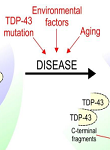|
|
|
Involvement of endoplasmic reticulum stress in TDP-43-linked neurodegenerative disease
|
|
|
|
|
|
|
|
|
|

|
|
|
Adam K. Walker
|
|
|
|
University of Pennsylvania
|
Center for Neurodegenerative Disease Research, Perelman School of Medicine, UPenn, Philadelphia, Pennsylvania 19104, USA
|
|
adwa@upenn.edu
|
|
|
|
|
|
|
|
|
|

|
Phosphorylated and ubiquitinated TAR DNA binding protein 43 (TDP-43) pathology is the neurodegenerative hallmark of the vast majority of amyotrophic lateral sclerosis (ALS) and approximately half of all frontotemporal lobar degeneration (FTLD) cases. An RNA/DNA-binding protein with diverse roles in the nucleus, TDP-43 accumulates in the cytoplasm of affected neurons and glia in disease, indicating that both a loss of normal nuclear function and additional gain of toxicity due to increased cytoplasmic presence likely occur in these TDP-43 proteinopathies. Abundance and splicing of hundreds of transcripts are affected by dysfunction of TDP-43, making identification of the key pathways involved in disease pathogenesis a difficult task. However, endoplasmic reticulum (ER) stress and activation of the unfolded protein response have been described in sporadic ALS patient tissues as well as in cell and animals models of widely-studied superoxide dismutase 1 (SOD1) mutation-linked ALS. These responses to misfolded proteins have more recently been demonstrated in models of TDP-43-linked disease, and modulation of ER stress, which is intimately associated with oxidative stress and formation of stress granules in cells, could therefore represent one avenue for potential amelioration of ALS and FTLD. This review summarizes recent findings describing the involvement of ER stress in TDP-43 proteinopathies.
|
|
|
|
|
|
|
|

|
|